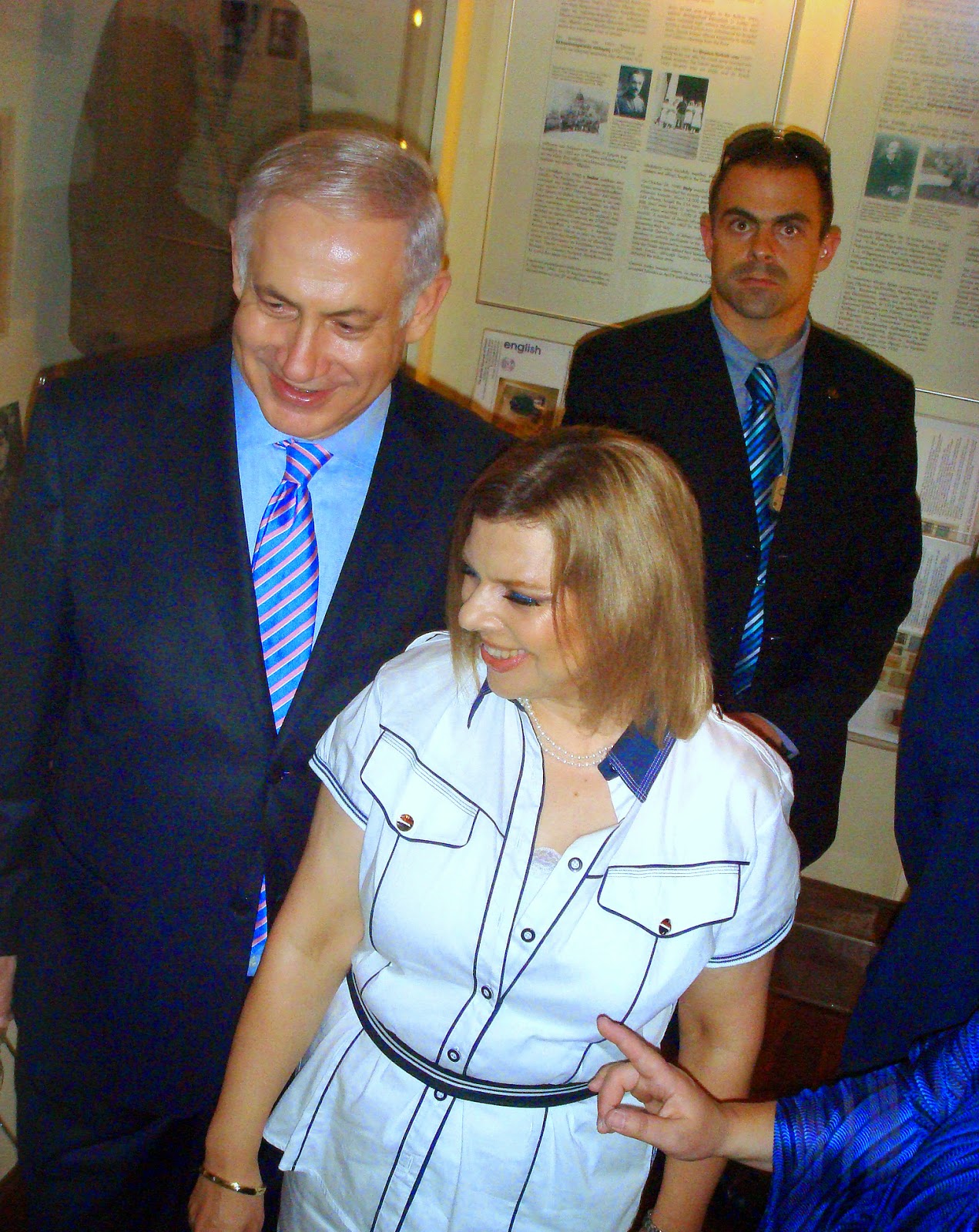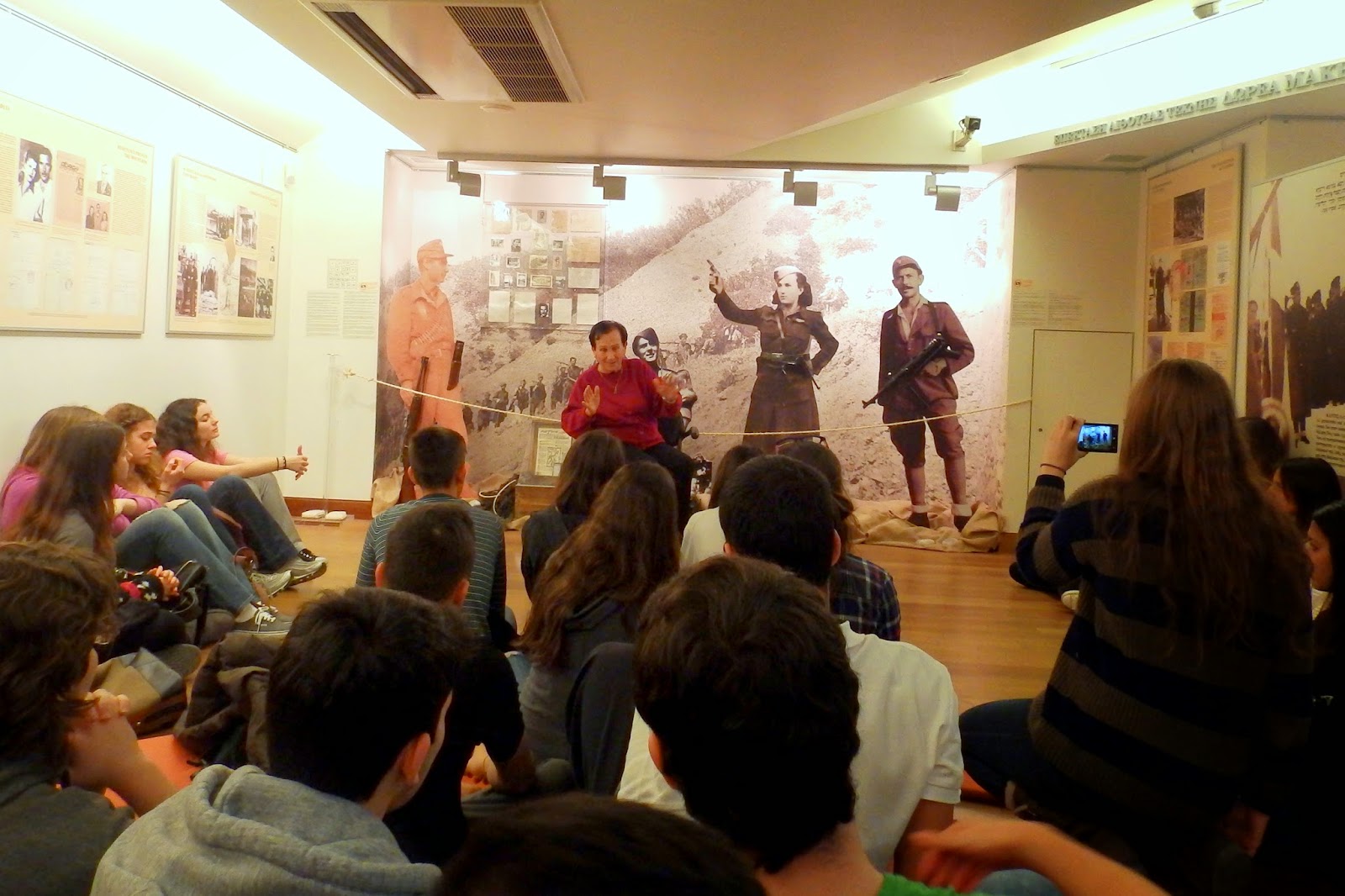המוזיאון היהודי באתונה - The Jewish Museum
בתמונה : חזית הכניסה למוזיאון היהודי באתונה
בתמונה : הקדשה מאת עיריית אתונה לזיכרו של הקולונל מרדכי פריזיס ז"ל,
הגיבור הלאומי היהודי של יוון, שנהרג במלחמת יוון - איטליה בשנת 1940.
ההקדשה נמצאת על קיר הכניסה למוזיאון היהודי באתונה.
בתמונה : ראש ממשלת ישראל מר בינימין נתניהו ורעייתו שרה מבקרים במוזיאון היהודי באתונה
הביקור התקיים ביום שני , בתאריך: 6.8.2010
הגיבור הלאומי היהודי של יוון, שנהרג במלחמת יוון - איטליה בשנת 1940.
ההקדשה נמצאת על קיר הכניסה למוזיאון היהודי באתונה.
בתמונה : ראש ממשלת ישראל מר בינימין נתניהו ורעייתו שרה מבקרים במוזיאון היהודי באתונה
הביקור התקיים ביום שני , בתאריך: 6.8.2010
המוזיאון הוא מבנה בן ארבע קומות, שנוספו לו בתקופה האחרונה מספר עמדות מולטי - מדיה משמעותיות המרחיבות את הידע ומאפשרות זמינות לתמונות רקע ויזואלי בצורה דיגיטלית ומודרנית (מסך מגע).
בתמונה : מוצגים מחיי היהודים, במוזיאון היהודי באתונה
בתמונה : תערוכה חדשה המוצגת במוזיאון היהודי באתונה,
בנושא "הפרטיזנים הלוחמים האמיצים היהודים מיוון", התערוכה נפתחה בחודש אפריל 2013
בשנת 2014 הוזמנה ע"י המוזיאון היהודי באתונה הגב' שרה פורטיס (אז שרה יהושוע) למתן מספר הרצאות על הפרטיזנים היא הרצתה בפני קבוצות של מורים ותלמידים שהו מרותקים לכל דבריה של הפרטיזנית הלוחמת .
בתמונה: כרזת התערוכה שהוצגה במוזיאון היהודי באתונה
נושא התערוכה הפרטיזנים היהודים בתקופת השואה
בשנת 2014 הוזמנה ע"י המוזיאון היהודי באתונה הגב' שרה פורטיס (אז שרה יהושוע) למתן מספר הרצאות על הפרטיזנים היא הרצתה בפני קבוצות של מורים ותלמידים שהו מרותקים לכל דבריה של הפרטיזנית הלוחמת .
בתמונה: כרזת התערוכה שהוצגה במוזיאון היהודי באתונה
נושא התערוכה הפרטיזנים היהודים בתקופת השואה
בתמונה : תלבושות אותנטיות של נשות סלוניקי כפי שלבשו אותן הנשים בעיר במאה ה - the 19th,
מוצגים במוזיאון היהודי בסלוניקי
בין המוצגים נמצא קטע משוקם של בית הכנסת העתיק בקורנית ובית הכנסת פאטרס, וכן תשמישי קדושה , פרטי לבוש, ציורים, פסלים, מסמכים ואבזרים מחיי היומיום של אחת הקהילות היהודיות העתיקות בעולם. ביקור וסיור במוזיאון היהודי באתונה מומלץ ביותר, לכל תייר ישראלי ולכל יהודי ויהודי המבקר בעיר אתונה ביוון - הוא ביקור חובה, שאסור לפספס אותו.
 |
| לכניסה לאתר האינטרנט של המוזיאון היהודי באתונה - ליחצו על התמונה העליונה! |
כתובת : רחוב ניקיס 39 , אתונה , Nikis st. 39, Athens 10557, Greece
טלפון : 30.210.322.5582 +
שעות פעילות : בימים שני - שישי , בין השעות: 9:00 - 14:30 ,
בימי ראשון בין השעות: 10:00 - 14:00 , בימי שבת המוזיאון סגור !
בימי ראשון בין השעות: 10:00 - 14:00 , בימי שבת המוזיאון סגור !
תחבורה ציבורית : מטרו - קווים 2,3 לתחנת "סינטגמה" Syntagma , באתונה .
The idea of building a Jewish Museum of Greece was first conceived in the 1970's by members of the Jewish Community of Athens, who offered every kind of assistance towards the realisation of this dream. The Museum was first established in 1977 and housed in a small room next to the city's synagogue. IT housed Objects salvaged from WW II, Whether artefacts, documents and Manuscripts of the 19 th and twenty th Centuries, or the jewelery of the Jews of Thrace That had been Seized by the Bulgarians in 1943. The Latter had been Returned to the Greek Government after the abdication of the Bulgarian king and the establishment of a communist regime in the country.
The following years saw a thorough and careful collection of material from all the communities of Greece, under the inspired guidance of Nikos Stavroulakis, director of the Museum until 1993. The collection expanded with rare books and publications, textiles, jewellery, domestic and religious artifacts , thanks to the interest of several individuals.
The Museum soon began to attract the attention of many visitors, researchers and donors. In 1981, the Association of American Friends was founded, followed, a little later, by the Association of Friends of the Jewish Museum of Greece, with members of the Jewish Communities of Athens and Thessaloniki.
As the Museum's collection grew and its activities expanded, it soon outgrew its first premises and new ones had to be found. In 1984, moved to IT A rented space Occupying the 3 rd Floor of 36, Amalias Avenue. The exhibition was reorganised into thematic units covering the interests of its various visitors. After years of efforts, the Museum acquired its legal status in 1989, as a non-profit foundation with a seven-member Board of Directors.
In the following years the Museum's activities expanded; they involved both the research and study of the Greek Jews - in collaboration with other foundations and researchers from Greece and abroad - and publishing. At the same time, its collection was being continuously enriched with new acquisitions from all over Greece, greatly exceeding all expectations. Increasing the Needs of the Museum for more space, Together with the Dream of Having its own sometime Premises, LED to the purchase of A nineteen th Century neoclassical Building, with the Support of its Friends in Greece and Abroad, the Jewish Community of Thessaloniki and the Central Board of Jewish Communities in Greece.
With substantial financial support from the Greek Ministry of Culture and the Associations of its Friends, the old building was renovated and, in late 1997, twenty years after it first opened its doors to the public, the Museum moved to 39 Nikis street, its new address in the centre of Athens.
On March on the 10th th , 1998, the new Building of the JMG was inaugurated and A new Area Begun for the Museum. In the following years it developed significantly and extended all its activities, and especially the educational ones. Also, it improved its visitors services and conducted thorough research efforts, the results of which were communicated through several temporary exhibitions and special publications. Contact and communication with the public and international relations and activities of the JMG, signal an extensive social and scientific information and influence exchange.
The idea of the Jewish Museum of Greece was born in the late '70s. The initiative belonged to the Jewish Community of Athens and some members offered any kind of support in this effort. In 1977 he founded a small museum, which was housed in a room adjacent to the Synagogue Street Melidoni.
There he gathered objects that survived the war, mainly articles and documents 19 th and 20 th century, as well as numerous religious vessels, jewelry and documents. The latter, which had been seized by the Bulgarians from the Jews of Thrace in 1943, returned and delivered to the Greek government after the resignation of the Bulgarian king and the establishment of the communist regime.
In the following years began a thorough and careful collection of material from all communities of Greece, under the inspired guidance of Nikos Stavroulakis, Director of the Museum until 1993. Due to the interest of several individuals, the collection was enhanced significantly with rare books and publishing, textiles , jewelery, rituals and utensils.
Soon, the museum began to attract the interest of many visitors from Greece and abroad, as well as scientists and donors, who were willing to contribute to its development. In 1981, the organization created "American Friends of the Jewish Museum of Greece" and, shortly afterwards, was founded by members of the Jewish Community of Athens and Thessaloniki, "The Association of Friends of the Jewish Museum of Greece," and since then constantly supports the Museum in each initiative.
The continuous enrichment of the museum and the expansion of its activities, soon necessitated the search for new space for their accommodation. Thus, in 1984, the collection was moved to a rented floor in building 36 Amalia Avenue and reorganized the report, covering the main topics of interest to the broad and heterogeneous audience of visitors. After years of efforts, the Museum acquired legal status in 1989. Since then works as NPID administered by a seven-member Board of Directors.
In the years that followed, the activity of the museum expanded considerably, both in research and study of Greek Jewry - in collaboration with other institutions and scientists from Greece and abroad - and in the field of publishing. At the same time, the collection has continued to be enriched with new acquisitions from all over Greece, surpassing the initial prospects. The Museum's growing needs for new facilities, but also the dream of owning their own home, led to the purchase of a listed building, with the support of the Friends of Greece and abroad, and the Community of Thessaloniki and the Central Jewish Council.
With the crucial financial support of the Ministry of Culture and the Association of Friends of the Museum, the building was renovated, so in late 1997, just twenty years after the founding of the Jewish Museum of Greece could be transferred to permanent longer own property, to the restored four-storey neoclassical building at Victory 39, in downtown Athens.
On March 10, 1998 inaugurated the new building of the JMG and a new era began for the Museum. In the following years developed especially and extended all its activities and particularly educational significantly improved services to the public and engaged in extensive research, the results of which were announced through a plurality of periodic reports and special publications. The contact and communication with the public and international relations and actions of JMG bidirectional signal social and scientific information and influence.

















אין תגובות:
הוסף רשומת תגובה